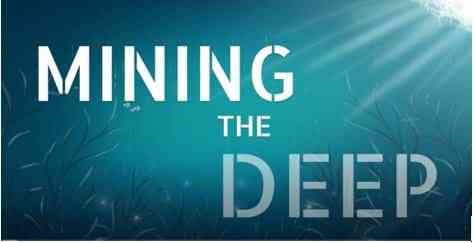

By 2050, the world's demand for precious metals will rise 500% to an astounding three billion tons of graphite, lithium, copper, and cobalt. As countries, such as the United States, transition to green energy the demand for metals to deploy wind, solar, and geothermal energy will be steep. To curb emissions and stay below a 2-degree Celsius rise, the renewable energy transition will be mineral intensive. A typical electric vehicle battery pack requires 8kg lithium, 35kg nickel, 20kg manganese, and 14kg of cobalt. Additionally, a charging station for EVs (Electric Vehicle) needs a large amount of copper, and solar panels require excessive amounts of Zinc.
By 2050, an eightfold increase in renewable energy investments will be needed to replace fossil fuels with low-carbon technologies. Current mining practices for these metals come at an environmental cost, health risk, and human rights issues. At current production rates, terrestrial mining will be 30-40% short of the rate of  demand in 2050. Today, the mining industry is posed with some large questions regarding sustainable mining, recycling metals, and producing metals at an unprecedented rate. Is there another way we can produce precious metals without destroying the local environment?
demand in 2050. Today, the mining industry is posed with some large questions regarding sustainable mining, recycling metals, and producing metals at an unprecedented rate. Is there another way we can produce precious metals without destroying the local environment?
Scientists have known about manganese nodules and precious metals being scattered across the ocean floor since the late 1800s. Progress only has begun in the last 30+ years due to technological advancements and economic demand. Manganese nodules are polymetallic rock concentrations that lie loosely on the sea floor and are abundant on the abyssal plains of the deep ocean. These plains are in different areas of the ocean but tend to be between 13,000 ft (about 3.96 km) to 20,0000 ft (about 60.96 km) deep.
The Clarion- Clipperton Zone is one of the largest areas of the several known economic zones and spans from the west coast of Mexico to the edge of Hawaii, covering an area of about 4.4 million square kilometers (about half the area of Canada). These metal ores are extremely pure and contain almost 100% usable minerals. Metal ores on land rarely have metal yields over 20% making the ocean ores far more concentrated. An estimated 21.1 billion dry tons of polymetallic nodules exist in the Clarion Clipperton Zone (CCZ), which eclipses the total of those found in global terrestrial sites. If deep ocean mining follows in the footsteps of petroleum, we can expect 30-45% of the demand for critical metals will come from deep ocean mines by 2065. The big question that still needs to be answered is, are the advantages in carbon, pollution, and social justice more important than the ecosystem damage to the ocean floor? How invasive is ocean mining compared to on land mining? These are all questions that are being tested, raised, and researched daily. To reach net zero, there will have to be tough decisions made, is this one of them?
With a fraction of the carbon footprint, no dependence on child labor, and a potentially large profit margins, why aren’t deep sea mining projects more popular? There seems to always be a “catch.” Deep sea mining has the possibility of causing mass habitat destruction and because the science behind deep sea life is limited, so are the known effects of the mining process.
One of the largest arguments against deep sea mining is the effects of sediment disruption and the sediment plumes formed by the collection of nodules. Currently, deep-sea mining proposals are expected to produce two distinct types of sediment plumes in the ocean: “collector plumes” that come from the vehicles on the sea floor and possibly “midwater plumes” that are discharged through pipes that descend 1,000 meters (about 3,281feet) or more into the oceans aphotic zone, where sunlight rarely penetrates. In 2018, a study conducted by MIT students on the impacts of deep-sea nodule mining found that sediment released from midwater plumes mixed rapidly with surrounding ocean water due to the turbulence of the release. The lack of policies regarding this process and the industry at large can be seen as a risk. Deep Sea mining is an evolving industry with an extensive range of effects that vary in seriousness. That is why it is important to take a heavily invasive industry, such as mining, very seriously. In response to increased interests, the UN (United Nations) created the International Seabed Authority (ISA), a governing body responsible for protecting and advocating for the seabed. The ISA is responsible for permitting exploration contracts and commercial contracts when it comes to that point.
In the end, commercial deep-sea mining will come down to a value of judgment. With the entire industry at an annual evaluation of a trillion dollars and upwards of 150 million dollars’ worth of gold sitting on the seabed, this is a gold mine (no pun intended). To meet the world's rigorous net zero goals, deep sea mining could provide the necessary materials for constructing our next generation's infrastructure.
With the continued guidance from the UN and technological advancements, the future of deep sea mining is looking to be promising. This is an opportunity to reform and alter the way the industrial world extract precious metals. Conservation groups are raising the necessary awareness around the environmental impacts of Deep-Sea Mining. It is important to listen to all sides of this conversation and to consider all key stakeholders. This is a massive economic opportunity that is not being taken lightly. The data from the exploration contracts granted by the ISA will be pivotal in the decision process and dictate the future of green technology. Currently there have been no commercial contracts granted, but they are expected to come by the summer of 2023. This is an intricated problem that involves ethics, sustainability, and economics.

